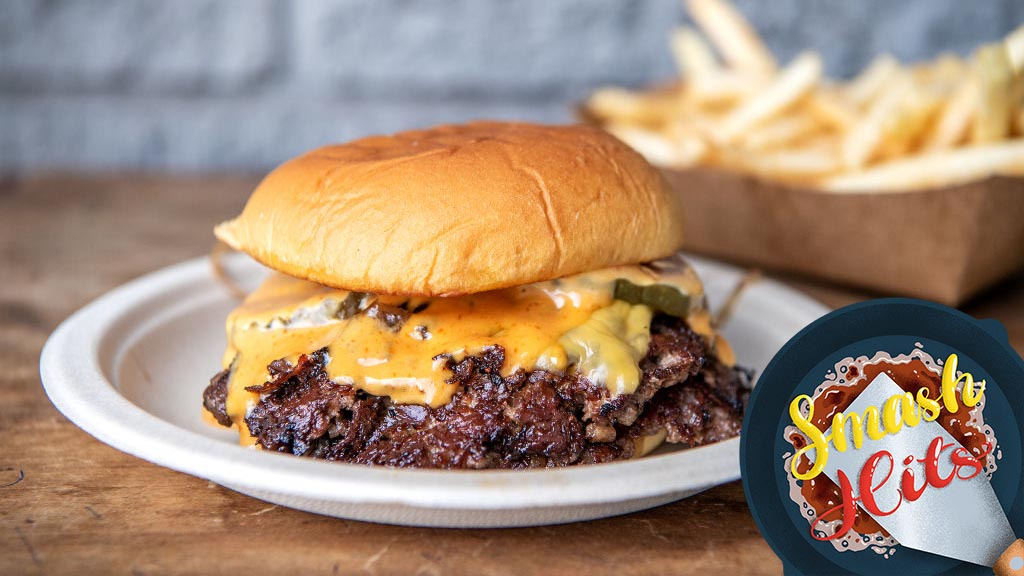Smash Hits: Burger Lessons From A Professional Flipper
Join us for a gradual descent into the greasy depths of burgerdom.
Welcome to Smash Hits, a five-part series in which a pro burger flipper tells you everything she knows about smash burgers and how to make a proper one at home.
The burger is a death sentence to the appetite. As a lifelong glutton, I've always avoided eating burgers for this reason. However, you don't have to dig deep into the American beefcake's humble origins to recognize that satiety was kinda the point.
It seems like the burger was not invented by any one person, although there are cities in Texas, Connecticut, Wisconsin, Ohio, and New York that each name inventors and claim to be its birthplace. It rose to prominence in America around the turn of the 20th century. Long before the drive-thru, burgers were sold from wagons in the street and stands at the fair to people who were not going to be sitting down at a table to eat. This minced or ground beef patty, potentially derived from a beef sausage, was a portable meal—a single dish that could satisfy a workingman's appetite.
The heft and thoughtless speed with which burgers demand to be eaten, the very qualities that originally turned me off to burgers, later caused me to spend three months of my life eating more burgers than any other food.
My burger reckoning began when I got a job cooking at a formerly Michelin-starred restaurant that made high-end, locally sourced bar food. Despite offering a whole trout, foie gras, oysters, mussels, and other more exciting dishes, the star of our sales mix for the summer was a double cheeseburger with pickles, caramelized onions, Dijonnaise, and white American cheese on a brioche bun.
If you've worked at a restaurant in any capacity you probably know that no matter what the government says, breaks are something you need to proactively ask for, and the maximum length of time deemed appropriate for a break is however long it takes your boss to smoke a cigarette. That's why, despite my lack of interest in burgers, I'd frequently find myself at the end of a shift pausing between cleaning out grease traps and mopping floors to shove a burger down my gullet. Coupled with weeks of honing my burger-cooking technique, I began to appreciate our menu's double cheeseburger for all that it was and was not.
I quickly learned that there are two camps of burger style: the big, juicy, thick-pattied burger, and the thin, crispy burger. My coworker, a talented cook who cut his teeth flipping burgers for half a decade, called the thick style a "dinner burger." They were popular throughout my childhood in the '90s and early 2000s, and are often portrayed as gourmet and served at steakhouses. Instead of chuck, they might be made with sirloin that's specified as Angus, Kobe, or Wagyu beef, and topped with wild things like onion rings and guacamole. Sometimes they may have bacon bits, jalapeños, cheese, and more mixed in with the ground beef. They require two hands (or a fork and knife) to eat. Whether grilled or griddled, they are cooked in the same way as a steak: to a specified level of doneness.
The double cheeseburger that changed my mind about burgers belonged to the thin patty family. These are the burgers made by fast food restaurants, drive-ins, and diners. They often come wrapped in foil or paper and can be eaten with one hand while sitting or standing. The smash burger exemplifies the category with a super-thin half-inch patty cooked to a crisp. Burger expert George Motz said in the August 2018 issue of Bon Appetit that "the thin patty is in," ostensibly kicking its fat sibling, the dinner burger, to the curb. I agree that at some point in the first couple decades of the 2000s, thin patties became cool again, and In-N-Out became a nationally recognized brand despite being exclusive to the West Coast.
In a burst of unfounded conjecture, I'll argue that the rise of the thin patty coincided with the recession of 2008 and 2009 in the same way that full skirts and an excess of fabric represented by Christian Dior's New Look coincided with the end of WWII and the subsequent economic boom. Sure, diner cooks have been smashing burger patties against flat-tops for decades, but it wasn't until the mid-aughts that Paris Hilton got a DUI en route to an In-N-Out.
Regardless of style, the recipe for a burger is so simple you can't call it a recipe: Beef, salt, bread, and optional toppings is more like a formula, and just like humanity's other brilliant formulas (general relativity comes to mind), its genius rests in its simplicity. It took me months of gorging on burgers, smashing patties into the plancha, and listening to my coworkers argue and shit-talk about the best burgers and burger cookery to understand that this simple formula can produce plenty of good burgers, but the greatest iterations always follow a few rules.
If you're game, please join me for a gradual descent into the greasy depths of burgerdom, where I'll share what I've learned about beef, buns, and toppings. But first: are you Team Dinner Burger or Team Smash Burger?
